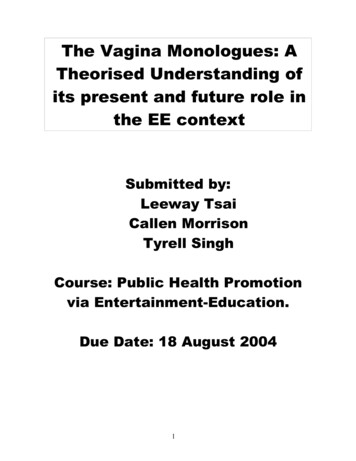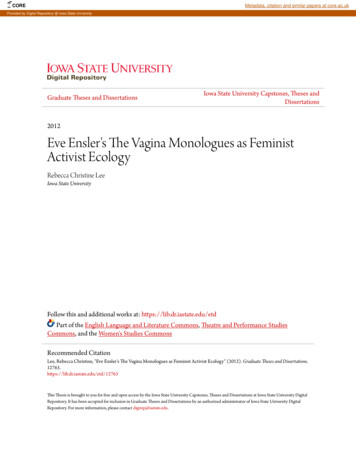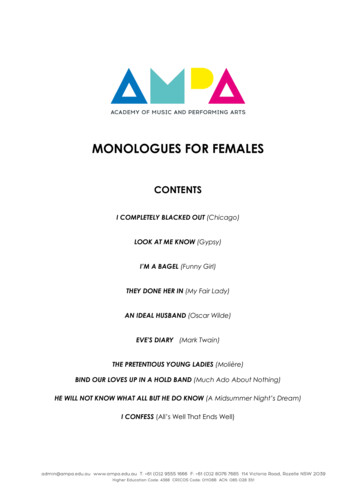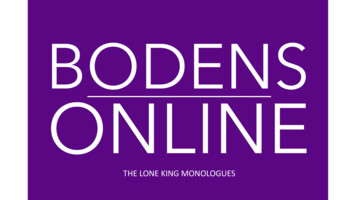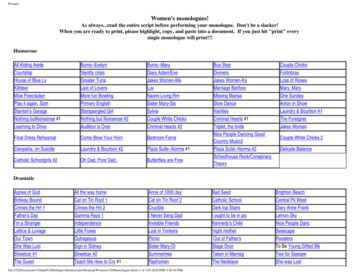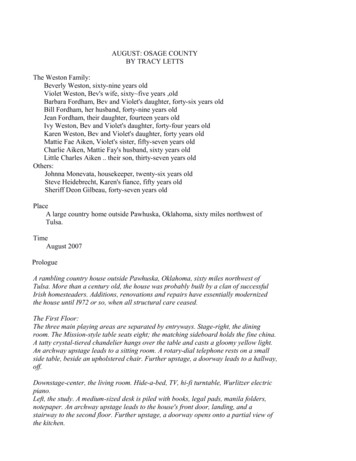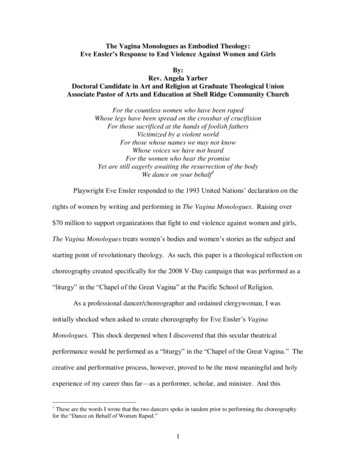
Transcription
The Vagina Monologues as Embodied Theology:Eve Ensler’s Response to End Violence Against Women and GirlsBy:Rev. Angela YarberDoctoral Candidate in Art and Religion at Graduate Theological UnionAssociate Pastor of Arts and Education at Shell Ridge Community ChurchFor the countless women who have been rapedWhose legs have been spread on the crossbar of crucifixionFor those sacrificed at the hands of foolish fathersVictimized by a violent worldFor those whose names we may not knowWhose voices we have not heardFor the women who hear the promiseYet are still eagerly awaiting the resurrection of the bodyWe dance on your behalf1Playwright Eve Ensler responded to the 1993 United Nations‟ declaration on therights of women by writing and performing in The Vagina Monologues. Raising over 70 million to support organizations that fight to end violence against women and girls,The Vagina Monologues treats women‟s bodies and women‟s stories as the subject andstarting point of revolutionary theology. As such, this paper is a theological reflection onchoreography created specifically for the 2008 V-Day campaign that was performed as a“liturgy” in the “Chapel of the Great Vagina” at the Pacific School of Religion.As a professional dancer/choreographer and ordained clergywoman, I wasinitially shocked when asked to create choreography for Eve Ensler‟s VaginaMonologues. This shock deepened when I discovered that this secular theatricalperformance would be performed as a “liturgy” in the “Chapel of the Great Vagina.” Thecreative and performative process, however, proved to be the most meaningful and holyexperience of my career thus far—as a performer, scholar, and minister. And this1These are the words I wrote that the two dancers spoke in tandem prior to performing the choreographyfor the “Dance on Behalf of Women Raped.”1
meaning stemmed in great part from the feminist theological lens through which Iapproached the choreography.The script does not call for a dance in the Vagina Monologues, but the directordecided that two monologues addressing the violence and suffering of rape needed to be“embodied in addition to spoken.” Thus, the “Dance on Behalf of Women Raped” waschoreographed and situated between “My Vagina Was My Village,” which discusses thehorrors of rape in Bosnia and Kosovo and “The Little Coochi Snorcher That Could,”which describes an adolescent experience of rape.Rather than organizing a neat thesis that attempts to cover the range of myreflections, I have formatted this paper in the same manner as the choreography. Assuch, I offer brief vignettes that speak to various themes and motifs within thechoreography. These vignettes are divided into movements, or sculptures, guided by themovements and bodily shapes of the choreography.Crucified WomanWe speak of the passion event, crucifixion, and it‟s odd that we hear this word: passion.A double entendre if you will. As Christians we know that, in this instance, we arereferring to the divine pathos of God—the passion of Christ‟s sacrifice, the outpouring oflove so deep that it leads to death on a cross. Yet in the everyday mundane of life thisword—passion—has an entirely different connotation. Rarely associated with what we“holy” people deem as “sacred,” passion more often refers to the flesh: sensual, lust,intimacy, sexuality.And it‟s ironic, perhaps even divinely coincidental, how these two connotations ofpassion merge in the act of crucifixion: a body on the cross suffering, naked, dying, and2
passionate. In no way have I witnessed this more profoundly than through artisticrenderings of the passion. Of course, being the feminist that I am, this passion is mademanifest in art work displaying a crucified Christ in female form.For example, in 1984 New York City witnessed a host of crucified women duringholy week. Saint John the Divine took the daring step of displaying Edwina Sandy‟s nowfamous sculpture, Christa, depicting a female figure crucified. At the same time UnionTheological Seminary displayed James Murphy‟s small clay sculpture, Christine on theCross, which depicted an inverted cross with a woman‟s arms nailed to the vertical beamand her legs spread on the horizontal crossbar—signifying the way in which rape anddomestic violence crucifies women on a daily basis. According to Union professor andliturgist, Janet Walton,Both crucifixes challenged the literal historical interpretation of the cross.They expressed an evolving interpretation which sees all humanityparticipating in the pain of crucifixion. In “Christine on the Cross” astatement of hostility and humiliation heaped upon women in the form ofrape and submission is visibly portrayed . . . The sculpture identified thesewomen and women of all ages as suffering servants who have beenwounded, broken and forsaken because of our inequities. 2In the choreography for the Vagina Monologues, I attempted to create anembodied response to the intersections of passion, bodies, rape, and sexuality. Drawingupon the themes of crucifixion and resurrection in James Murphy‟s sculpture, the dancersshared this embodied vulnerability as a symbol of God‟s passion and theirs.Bodies and Theologies UnfoldIn the same way that Luce Irigaray describes the layered and infinite unfolding of“woman,” or Catherine Keller describes the layered and infinite unfolding of Trinity, so Iendeavored to embody this unfolding with real bodies, real dancers, real women. As2Janet Walton, Art and Worship (Collegeville: Liturgical Press, 1988), 106.3
such, the two professional dancers weren‟t necessarily the most technically trained, andthey both had average female bodies (for dancers). They were not the emaciated sylphsof ballet, but real women‟s bodies. The choreography performed by two curvy womenunfolds differently than it would if the two women were emaciated and thin, and this wasintentional. Irigaray‟s concept of sensible transcendence undergirds my choreography astwo women, two dancers, fold and unfold, becoming and embodying the holy, “you/Ibecome two but thus divided in two, one outside, the other inside, you no longerembrace yourself, or me You become whatever touches you Between us, there‟s norupture between virginal and nonvirginal.” 3 The choreography endeavored for thedancers to become one another, to become divine, through infinitely connectedmovements, through touch and through embracing the self and the other.Performing Gender IdentityFurthermore, the way in which the two dancers embodied their “gender roles” reflectsJudith Butler‟s notion of performative acts constituting identity. Butler notes the way inwhich philosophers “rarely think about acting in the theatrical sense, but they do have adiscourse of „acts‟ that maintains associative semantic meanings with theories ofperformance and acting [gender] is an identity tenuously constituted in time—anidentity instituted through a stylized repetition of acts.”4 In this way, my choreographywas an attempt at embodying Butler‟s theory, of “acting out” the discourse ofphilosophers through a repetition of movements. This was manifested in simple ways,such as both dancers sharing equal roles in lifting and being lifted. There was no need for3Luce Irigaray, This Sex Which Is Not One. (Ithaca: Cornell University Press, 1985), 210-211.4Judith Butler, “Performative Acts and Gender Constitution: An Essay in Phenomenology and FeministTheory,” Theatre Journal 49:1 (December 1988): 401-402.4
a man to sweep in and perform his gender role by lifting a female sylph into the air;instead there were two, strong women who lifted one another, subverting classicaldefinitions of movement-vocabulary and of gender identity.Holy Vagina, Sacred Pleasure, and a History of PatriarchyIn her introduction to the Vagina Monologues, Gloria Steinem reminds us of the historyof the feminine divine in religion:Gnostic Christians worshiped Sophia as the female Holy Spirit andconsidered Mary Magdalene the wisest of Christ‟s disciples; TantricBuddhism still teaches that Buddhahood resides in the vulva; the Sufimystics of Islam believe that fana, or rapture, can be reached only throughFravashi, the female spirit; The Shekina of Jewish mysticism is a versionof Shakti, the female soul of God; and even the Catholic church includedforms of Mary worship that focused more on the Mother than on the Son.In many countries of Asia, Africa, and other parts of the world where godsare still depicted in female as well as male forms, altars feature the Jewelin the Lotus In India, the Hindu goddesses Durga and Kali areembodiments of the yoni powers of birth and death, creation anddestruction. 5In a similar vein, Raine Eisler‟s entire text, Sacred Pleasure, recounts the shift in historyfrom what she calls partnership-oriented societies to where we now reside in dominatororiented societies.6 Eisler differentiates sacred pleasure from the “holy” pleasure manyChristians in the Middle Ages ascribed to, which derived from self-inflicted torture inorder to identify with the suffering of Christ. She highlights the way in which the view ofthe “sacred conveyed by thousands of religious representations of cruelty and sacrifice—of the human body pierced, crucified, incinerated, impaled, and otherwise hideouslytormented—that to our day fill both our museums and our churches,” 7 is not what ancient5Gloria Steinem, “Foreword,” in Vagina Monologues (New York: Villard, 2001), xxx-xxxi.Eisler, Riane. Sacred Pleasure: Sex, Myth, and the Politics of the Body—New Paths to Power and Love.San Francisco: HarperSanFrancisco, 1995.7Eisler, 168.65
partnership-oriented societies would have deemed “sacred.” What is it about bloody,sacrificed violence that so fascinates the theologian and devotee of Christ? 8In this regard, my choreography sought to return to these ancient partnershiporiented models of the sacred by creating equal movements where each dancer relied onthe other dancer to shape, move, and lift, and visa versa. The movements sought to besensual and sacred, ambiguous so that the viewer could determine for herself what themovements embodied and meant.Saying the Unsayable: Our Lips Speaking/Moving TogetherGloria Steinem speaks of the Vagina Monologues as “the power of saying theunsayable.”9 Ensler describes the process of “speaking the word,” saying the very word,“vagina,” and the power of uttering the unspeakable:The excitement and danger of speaking the word, of performing the playin tiny villages or conservative cities, with unlikely performers (ministersand doctors and telephone workers and members of parliament) and inunusual venues (churches and synagogues, women‟s living rooms,stadiums, factories), has propelled the play to be performed in 45languages and 119 countries.10For Ensler, the word that must be spoken is clearly “vagina,” and this word isrepresentative of the unspeakable, the taboo. But the way in which Ensler describes the“word,” seems also to parallel the way in which many Christian theologians refer tospeaking the “Word,” logos, the Gospel of Christ. And perhaps this parallel is not assacrilegious as it may first appear; for both words must be spoken. The speaking of bothwords leads to a type of salvific liberation and freedom. Is not the “word” Jesus8Rita Nakashima Brock and Rebecca Parker answer such a question throughout their most recent book,Saving Paradise: How Christianity Traded Love of This World for Crucifixion and Empire; however, thescope and limit of this project prevent me from discussing this further here.9Gloria Steinem, xxxiv.10Eve Ensler, xiii-xiv.6
proclaims, “let the oppressed go free”? So, too, is the purpose of Ensler‟s “word.”Further, Irigaray offers insightful sentiments regarding the power of “when ourlips speak together,” in this instance women‟s “lips” undoing what men‟s mouths havealways pontificated, the lips referring to both the mouth (boca) and the lips of the vagina:But what about us? Come out of their language. Try to go back throughthe names they‟ve given you. I‟ll wait for you, I‟m waiting for myself.Come back. It‟s not so hard. You stay here, and you won‟t be absorbedinto familiar scenes, worn-out phrases, routine gestures. Into bodiesalready encoded within a system. Try to pay attention to yourself. To me.Without letting convention, or habit, distract you. 11In a similar manner, Yvonne Yarbro-Bejarano describes Cherríe Moraga‟s poetry, callingit a sexual/textual project where “the mouth fuses two taboo activities: female speakingand lesbian sexuality. „Mouth‟ and „sex‟ merge, both represented as organs of speechand sex.”12 The choreography for the Vagina Monologues was rendered taboo by severalwatchers; it sought to “speak” through the body what is often left unsaid and unheard inchurches, in liturgy, and in theology. The movements were described by some ashomoerotic, erotic, sexual, provocative. These movements were intentional ways toescape the “routine gestures” and “worn out phrases” Irigaray speaks of, to fuse twotaboo activities: female speaking and lesbian sexuality.My Vagina Was My VillageThe monologue preceding the dance was “My Vagina Was My Village.” In 1994 EveEnsler spent two months in Croatia and Pakistan, interviewing Bosnian women refugees.When she returned to New York she says, “I was in a state of outrage. Outraged that20,000 to 70,000 women were being raped in the middle of Europe in 1993, as systematic11Luce Irigaray, 205-206.Yvonne Yarbro-Bejarano, The Wounded Heart: Writing on Cherríe Moraga. (Austin: University ofTexas Press, 2001), 6.127
tactic of war, and no one was doing anything to stop it over 50,000 women were rapedevery year in this country [United States], and in theory we were not at war.”13 So,Ensler responded by crafting “My Vagina Was My Village.”This monologue juxtaposes the voice of a young woman delighting in fresh,innocent, and new sexual encounters with someone she loves with the voice of a youngwoman brutally gang-raped by soldiers. The sweet and chatty voice of the innocentlover‟s vagina is silenced when the foiled voice describes her experience:Not since the soldiers put a long thick rifle inside me. So cold, the steelrod canceling my heart. Don’t know whether they’re going to fire it orshove it through my spinning brain. Six of them, monstrous doctors withblack masks shoving bottles up me too. There were sticks, and the end ofa broom.14While there are no words that can follow such a brutal description, and dancing followingtheir hearing caused me to feel sick at my stomach, Irigaray‟s words regarding thesilencing and brutality women face seem apropos, “How, how many times, are we goingto have to be cut into „parts,‟ „hammered,‟ „recast ‟ in order to become sufficientlysignifying? Substantial enough?”15 Further, while referring to “My Vagina Was aVillage,” Isherwood surmises, “Indecent theology does not shield its eyes and avert itsgaze from these unpleasant realities. It declares the free, happy, wet homeland of thevagina as both original creation and eschatological hope.”16In creating choreography that would follow such a graphic portrayal of rape, I,like Isherwood, felt a tremendous need to end on a movement of eschatological hope.13Ensler, 60.Ensler, 62.15Luce Irigaray, 92.16Lisa Isherwood, “Indecent Theology: What F-ing Difference Does It Make?,” Feminist Theology 11:2(January 2003), 145.148
Not hope that negates or forgets the horrors of what has happened. Not hope that ignoresthe realities of suffering, but the hope that occurs when women who have suffered jointogether to comfort one another and to stand against injustice. As such, the closinggesture of choreography involved both dancers reaching out their hands until they slightlytouched, joining together, and slowly embracing. The rationale behind this closingmovement is also based on the monologue that followed the dance, “The Little CoochiSnorcher that Could.”The Little Coochi Snorcher that CouldFor ten years, Eve Ensler interviewed homeless women, and after interviewing hundredsof women, she only met two were not subjected to incest or rape.17 “The Little CoochiSnorcher that Could” is a monologue based on one woman‟s brutal story as Ensler noteshow poor women suffer terrible violence that goes unreported because of their socialclass. The story of this woman, while violent and horrifying, ends in hope as she metanother woman in a shelter, fell in love, and through their love, they got out of the sheltersystem and “have a beautiful life together.”18 The monologue recounts this homelesswoman‟s vaginal experiences throughout childhood and early adolescence, including thetime that Edgar Montane, another little boy, punched her in the coochi snorcher, andwhen she is scolded by her mother for letting a boy touch her coochi snorcher, she cries,“he didn‟t touch it, Mama, he punched it.”19 At age ten, the little girl is raped by herfather‟s friend Alfred and her father responds by shooting Alfred in front of his daughter.And by age sixteen, the young girl experiences “salvation” through a lesbian experiencewith an older woman. Upon reflecting back on her first experience with a woman, after17Ensler, 76.Ensler, 76.19Ensler, 78.189
her vagina had been ravaged by men, she stated poignantly, “I realized later she was mysurprising, unexpected, politically incorrect salvation. She transformed my sorry-asscoochi snorcher and raised it up into a kind of heaven.”20Ideally, I wanted my choreography to reflect the journey of this little girl inaddition to addressing the themes of rape, crucifixion, resurrection, and sexuality. Iwanted the movements to embody both the pain and horror of their stories in addition tothe beauty, salvation, and liberation many of these women found in caring and mutualrelationships with other women. So, the closing gestures of the choreography also reflectthis woman‟s story, as she tentatively reached out her hand and was touched in anunexpected way by a woman who raised her up into a kind of heaven through herembrace.Surprising ResponsesThus far I have reflected theologically on the choreography I created for the VaginaMonologues, but now I would like to share some of the responses that made the processso meaningful. The show was performed only once for an audience of around 300; wealso had an open dress rehearsal where close to 100 people attended. And “The Dance onBehalf of Women Raped” was performed without the corresponding monologues as apart of a Palm/Passion Sunday worship service in a local Baptist church where roughly75 people were in attendance. So, fewer than 500 people saw the dance. But I cannotbegin to recount the number of responses from women who shared with me how theywere sexually abused or raped at some point in their life. The numbers are too great torecall. One story is too poignant not to tell.20Ensler, 82.10
A woman in her late sixties approached me following the performance. She wasalso a modern dancer in her younger years and talked with me about the movementvocabulary and choreography choices. At the end of our conversation her voice began totremble and her eyes filled with tears and she sat down and told me about how her olderbrother sexually abused her for nearly six years throughout her adolescence. She felt soashamed that she had never told anyone— for sixty years. But she took my hands in hersand said, “But now I‟m telling you.” Since she shared her experience with me, we havebeen in conversation, and she has begun seeing a counselor and sharing her story withyoung girls who have recently been abused. She told me, “Your dance gave me thecourage to speak my hurt.” And it is her story that made the entire experience worthwhile.Conclusions: My Politically Incorrect SalvationIn conclusion, dancing this choreography in the Vagina Monologues was like my“politically incorrect salvation.” Because, as Isherwood and Althaus-Reid contend,“women‟s bodies may be the starting points for theological revolution.” 21 Mychoreography was my attempt at using women‟s bodies, real dancing bodies, as a startingpoint for theology. The choreography and the theology to which it ascribes is one thatdoes not adhere to traditional notions of soteriology and atonement that have renderedbroken women mute for centuries. Rather it is a theology and a dance that embodieswomen‟s sexuality—both pleasured and pained—as a part of the sacred process ofbecoming God‟s body here on earth. For, as Isherwood contends, “It is time to starttelling that it was not a sanctuary that held Jesus but a womb, he too took the walk downthe vaginal aisle and arrived in a world of shit, blood, weeping, propelled into hopeful21Isherwood, 142.11
arms.”22 So, with all of these words in mind, I close with the words I spoke in a localcongregation before we shared this choreography on Palm/Passion Sunday:There is a chance this dance will make you uncomfortable. Perhaps youwill want to avert your eyes. Perhaps the same is true when it comes tothe pathos of God. We dance on behalf of women raped and forgotten—who have never had the chance to find sanctuary. In our dancing,however controversial or uncomfortable it may be, we give them respite inthis space with our bodies. After all, doesn‟t everyone deserve theopportunity for resurrection?22Isherwood, 145.12
BibliographyAlthaus-Reid, Marcella. Indecent Theology: Theological Perversions in Sex, Gender,and Politics. London: Routledge, 2001., ed. Liberation Theology and Sexuality. London: Ashgate Publishing, 2006.Armour, Ellen, and Susan St. Ville, ed. Bodily Citations: Religion and Judith Butler.New York: Columbia University Press, 2006.Browning, Barbara. “Breast Milk is Sweet and Salty (A Choreography of Healing).” InOf the Presence of the Body, ed. André Lepecki, 97-112. Middletown:Wesleyan University Press, 2004.Butler, Judith. “Against Proper Objects.” Differences: A Journal of Feminist CulturalStudies 6 (1994): 1-26. Gender Trouble: Feminism and the Subversion of Identity. New Yorkand London: Routledge, 1990.“Performative Acts and Gender Constitution: An Essay inPhenomenology and Feminist Theory.” Theatre Journal 49:1 (December 1988):519-531. Sexing the Body: Gender Politics and the Construction of Sexuality.Jackson: Basic Books, 2000.Eisler, Riane. Sacred Pleasure: Sex, Myth, and the Politics of the Body—New Paths toPower and Love. San Francisco: HarperSanFrancisco, 1995.Eliade, Mircea. The Sacred and the Profane. Translated by Willard Trask. New York:Harper and Row Publishers, 1957.Ensler, Eve. The Vagina Monologues. New York: Villard, 2001.Hamera, Judith. “I Dance to You: Reflections on Irigaray‟s I Love To You in Pilates andVirtuosity.” Cultural Studies 15:2 (2001): 229-240.Hammers, Michele Lee. “The Vagina Monologues: Staging Complex Questions AboutRhetorical Theory and Practice.” Ph.D. Dissertation, Arizona State University,2004.Hanna, Judith Lynne. Dance, Sex and Gender: Signs of Identity, Dominance, Defiance,and Desire. Chicago: University of Chicago Press, 1988.13
Irigaray, Luce. An Ethics of Sexual Difference. Translated by Carolyn Burke and GillianGill. Ithaca: Cornell University, 1993. I Love To You: A Sketch of a Possible Felicity in History. Translated byAlison Martin. New York: Routledge, 1996. This Sex Which Is Not One. Ithaca: Cornell University Press, 1985. To be Two. New York: Routledge, 2001.Isherwood, Lisa. “Indecent Theology: What F-ing Difference Does it Make?” FeministTheology 11:2 (January 2003): 141-147.Jensen, Eleanor R. “Concerning Vaginas: an Exploration of Womanhood, Social Changeand Community.” Thesis, Coe College, 2002.Lamb, Brett Loraine. “The Vagina Monologues: Eve Ensler Reclaims Women'sSexuality.” M.A. Thesis, Clemson University, 2001.Lepecki, André. “Presence and Body in Dance and Performance Theory.” In Of thePresence of the Body, ed. André Lepecki, 1-13. Middletown: WesleyanUniversity Press, 2004.Mackendrick, Karmen. “Embodying Transgression.” In Of the Presence of the Body, ed.André Lepecki, 140-156. Middletown: Wesleyan University Press, 2004.McCue-Enser, Margret Ann. “Consciousness Raising, the Body, and the Self: ARhetorical Analysis of Ten Women's Interpretations of The Vagina Monologues.”Ph. D. Dissertation, University of Iowa, 2006.Walter, Janet. Art and Worship. Collegeville: Liturgical Press, 1988Ware, Kimberly Ann. “Understanding the Effect of the Performance on the Performer:Self-Reflection and Awakening in The Vagina Monologues.” M.A. Thesis,Arizona State University, 2005.Yarbro-Bejarano, Yvonne. The Wounded Heart: Writing on Cherríe Moraga. Austin:University of Texas Press, ***************************This work is licensed under the Creative Commons Attribution-Noncommercial-NoDerivative Works 3.0 License. To view a copy of this license, 3.0/ or send a letter to Creative Commons,543 Howard Street, 5th Floor, San Francisco, California, 94105, USA. Orhttp://creativecommons.org/.Rev. Angela Yarber 200914
15
The Vagina Monologues treats women‟s bodies and women‟s stories as the subject and starting point of revolutionary theology. As such, this paper is a theological reflection on choreography created specifi

